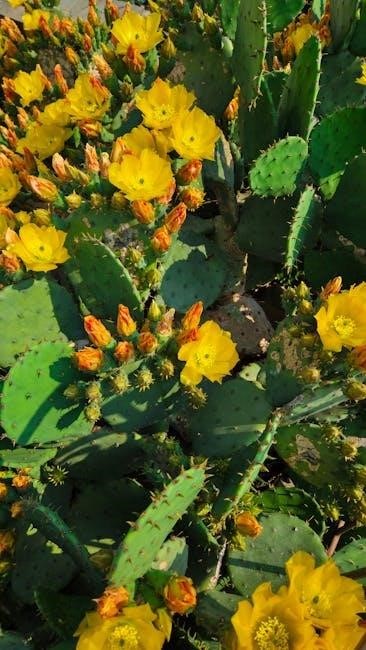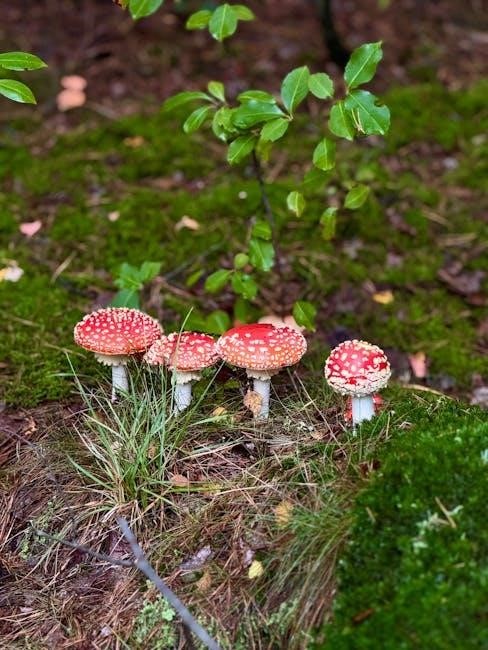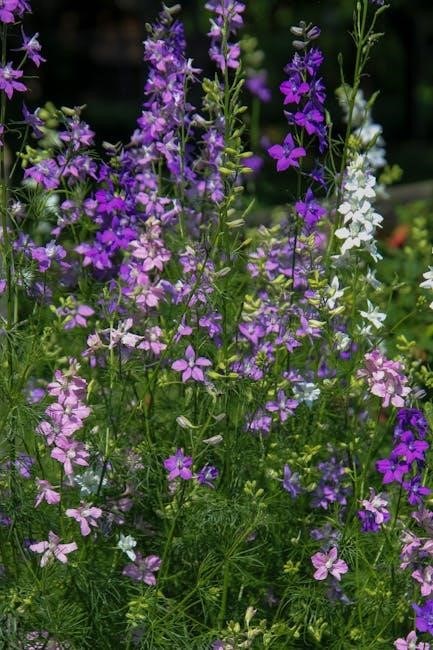Hallucinogenic plants have been used for centuries in various cultures for spiritual‚ medicinal‚ and ceremonial purposes. Their unique psychoactive compounds alter perception‚ offering insights into human consciousness. Hallucinogenic Plants ー A Golden Guide provides a comprehensive overview of their history‚ cultural significance‚ and effects‚ serving as an essential resource for researchers and enthusiasts alike.
1.1 Historical Overview
Hallucinogenic plants have been used for thousands of years‚ with early humans discovering their psychoactive properties during foraging. Ancient civilizations incorporated these plants into rituals‚ spiritual practices‚ and medicine. Examples include the use of ayahuasca in Amazonian cultures and peyote in Native American traditions. These plants played a pivotal role in shaping cultural‚ religious‚ and social dynamics‚ bridging the natural and spiritual worlds. Their historical significance remains a cornerstone of modern research and cultural appreciation.
1.2 Cultural and Religious Significance
Hallucinogenic plants have deep cultural and religious significance‚ often serving as sacred tools in rituals and ceremonies. They are revered for their ability to connect users with the divine‚ offering spiritual insights and enlightenment. In many indigenous traditions‚ these plants are considered gateways to other realms‚ facilitating communication with ancestors and spirits. Their use in sacred contexts highlights their profound impact on human belief systems and cultural identity across the globe.

Ethnobotany of Hallucinogenic Plants
Ethnobotany explores the traditional uses of hallucinogenic plants in ancient societies‚ emphasizing their role in sacred rituals‚ healing‚ and cultural practices. This field highlights their enduring significance in human history and identity.
2.1 Traditional Uses in Ancient Societies
Hallucinogenic plants have been integral to ancient cultures‚ used in rituals‚ spiritual ceremonies‚ and healing practices. In Mesoamerica and the Amazon‚ shamans employed these plants to communicate with spirits‚ foresee the future‚ and heal ailments. Their use was deeply tied to cultural identity‚ serving as bridges between the physical and spiritual worlds‚ and remain central to indigenous traditions and wisdom. Hallucinogenic plants shaped societal beliefs and practices for centuries.
2.2 Role in Shamanic Practices
Hallucinogenic plants have been integral to shamanic rituals‚ enabling spiritual leaders to communicate with spirits‚ heal ailments‚ and divine the future. Shamans use these plants to enter altered states‚ facilitating connections between the physical and spiritual realms. Their role is deeply rooted in cultural and spiritual traditions‚ serving as tools for guidance‚ healing‚ and enlightenment in indigenous communities worldwide. Hallucinogens remain central to shamanic practices‚ preserving ancient wisdom and cultural identity.
Chemical Compounds in Hallucinogenic Plants
Hallucinogenic plants contain psychoactive compounds like alkaloids‚ psilocybin‚ and DMT. These substances alter perception by interacting with brain receptors‚ particularly serotonin‚ inducing profound mental and physical effects.
3.1 Alkaloids and Their Effects
Alkaloids are key psychoactive compounds in hallucinogenic plants‚ interacting with serotonin receptors to alter perception. Found in plants like Datura and Brugmansia‚ alkaloids such as scopolamine and atropine induce sensory distortions‚ hallucinations‚ and altered consciousness. These compounds can cause increased heart rate‚ delirium‚ and disorientation‚ highlighting their potent and complex effects on the human nervous system.
3.2 Psilocybin‚ DMT‚ and Other Key Compounds
Psilocybin‚ found in psychoactive mushrooms‚ and DMT‚ present in plants like Ayahuasca‚ are potent hallucinogens. These compounds bind to serotonin receptors‚ altering perception and inducing vivid hallucinations. Psilocybin promotes introspective experiences‚ while DMT generates intense‚ otherworldly visuals. Other key compounds‚ such as mescaline and bufotenin‚ also modify consciousness‚ creating sensory distortions and emotional shifts. Their unique effects have made them central to shamanic rituals and scientific study‚ offering insights into the brain’s chemistry and human cognition.
Legal and Safety Considerations
Hallucinogenic plants are illegal in many countries‚ classified as controlled substances. Their use poses health risks‚ including mental instability and adverse reactions‚ requiring medical supervision.
4.1 Legal Status Around the World
The legal status of hallucinogenic plants varies globally. Many countries classify them as controlled substances‚ prohibiting cultivation and possession. However‚ some nations allow their use in religious or traditional practices. For example‚ peyote is illegal in most regions but is permitted for religious use in the United States under the American Indian Religious Freedom Act. Similarly‚ ayahuasca is legal in Peru for cultural practices but banned in others. Understanding local laws is crucial to avoid legal repercussions.
4.2 Potential Risks and Side Effects
Hallucinogenic plants can pose significant risks‚ including adverse reactions and psychological distress. Immediate side effects may include nausea‚ increased heart rate‚ and paranoia. Long-term use can lead to tolerance‚ dependency‚ or mental health issues. The potency of these plants varies‚ and improper preparation or dosage can exacerbate risks. Responsible use and medical supervision are essential to mitigate potential harm and ensure safe experiences.

Popular Hallucinogenic Plant Species
Peyote‚ Ayahuasca‚ and Datura are prominent hallucinogenic plants‚ each with unique cultural and historical significance‚ offering profound psychological and spiritual experiences when used in traditional settings.
5.1 Peyote (Lophophora williamsii)
Peyote (Lophophora williamsii) is a small‚ spineless cactus native to the southwestern United States and northern Mexico. It has been used for centuries in Native American rituals for its psychoactive alkaloids‚ particularly mescaline. The plant is ingested in the form of dried buttons‚ causing vivid hallucinations and introspective states. Peyote holds significant cultural and spiritual value‚ especially among indigenous communities‚ and is legally protected for religious use in some regions‚ while its conservation status remains a concern due to overharvesting.
5.2 Ayahuasca (Banisteriopsis caapi)
Ayahuasca is a powerful hallucinogenic brew made from the Banisteriopsis caapi vine and other plants like Psychotria viridis. It contains the psychoactive compound DMT‚ which induces profound visual and introspective experiences. Traditionally used in Amazonian shamanic rituals for healing and spiritual exploration‚ Ayahuasca has gained global popularity for its potential therapeutic benefits and deep cultural significance‚ while its legal status varies widely across countries‚ sparking ongoing debates about its use and regulation.
5.3 Datura (Jimson Weed)
Datura‚ commonly known as Jimson Weed‚ is a highly potent hallucinogenic plant containing tropane alkaloids like scopolamine and hyoscyamine. It has been used in traditional rituals for its psychoactive effects‚ which include vivid hallucinations and altered perception. However‚ its use is extremely risky due to its toxicity and unpredictable outcomes‚ leading to severe physical and mental side effects. Historical records show its use in shamanic practices‚ but modern consumption is often discouraged due to its dangerous nature.

Practical Uses and Preparations
Hallucinogenic plants are traditionally prepared through brewing‚ infusions‚ or ceremonial rituals. Modern applications focus on medicinal research‚ exploring their potential for therapeutic and spiritual growth purposes.
6.1 Traditional Methods of Consumption
Hallucinogenic plants have been traditionally consumed through rituals‚ often brewed into teas or infusions. Ayahuasca‚ for example‚ is prepared by combining Banisteriopsis caapi with other plants. Datura seeds are sometimes infused in water or smoked. Shamans play a central role‚ guiding ceremonies to ensure safe and meaningful experiences. These methods emphasize spiritual connection‚ healing‚ and communal bonding‚ preserving ancient cultural practices for generations.
6.2 Modern Applications in Medicine
Modern medicine is exploring hallucinogenic plants for therapeutic potential. Psilocybin from mushrooms is being studied for treating PTSD and depression. Ayahuasca’s alkaloids show promise in addiction recovery. Researchers are investigating these compounds’ ability to reset brain circuits‚ offering new avenues for mental health treatment. Clinical trials are underway‚ paving the way for potential breakthroughs in psychiatry and neurology‚ while maintaining respect for their traditional cultural significance.
Conservation and Sustainability
Hallucinogenic plants face threats from overharvesting and habitat loss. Conservation efforts focus on sustainable cultivation and protecting wild populations to preserve these species for future generations.

7.1 Threats to Hallucinogenic Plant Species
Hallucinogenic plants face significant threats from habitat destruction‚ overharvesting‚ and climate change. Many species are illegally harvested‚ disrupting ecosystems and threatening their survival. Conservation efforts are critical to protect these plants and their cultural significance for future generations.
7.2 Efforts to Preserve Sacred Plants
Efforts to preserve hallucinogenic plants include sustainable harvesting practices and conservation programs. Organizations collaborate with indigenous communities to protect these species and their habitats. Educational initiatives raise awareness about the importance of these plants‚ promoting their responsible use. Controlled cultivation and legal frameworks also help ensure their survival for future generations.

Resources for Further Reading
Hallucinogenic Plants ⎯ A Golden Guide and Plants of the Gods are highly recommended. These resources provide detailed insights into the history‚ cultural significance‚ and scientific aspects of hallucinogenic plants.
8.1 Recommended Books on Hallucinogenic Plants
Hallucinogenic Plants: A Golden Guide by Richard Evans Schultes is a seminal work‚ offering insights into the cultural and scientific significance of psychoactive plants. Plants of the Gods by Albert Höfer and Dietrich Rätsch explores their sacred and healing properties. Pharmako/Poeia by Dale Pendell delves into the history and use of psychoactive substances. These books provide a comprehensive understanding of hallucinogenic plants‚ blending history‚ ethnobotany‚ and modern research.

8.2 Online Archives and PDF Guides
Several online archives offer free PDF guides on hallucinogenic plants‚ such as Hallucinogenic Plants: A Golden Guide by Richard Schultes‚ available for download. These resources provide detailed information on the history‚ cultural significance‚ and chemical compounds of psychoactive plants. Archives like Scribd and ResearchGate host comprehensive guides‚ including Comprehensive Guide to Hallucinogenic Plants‚ which cover topics from traditional uses to modern research. These PDFs are invaluable for researchers and enthusiasts alike.
Hallucinogenic plants hold profound cultural and scientific significance‚ shaping human history and consciousness. The Hallucinogenic Plants: A Golden Guide provides essential insights into their roles and potential.
9.1 The Future of Hallucinogenic Plant Research
Research into hallucinogenic plants is expanding‚ driven by advancements in neuroscience and botany. Scientists are exploring their therapeutic potential‚ particularly for mental health disorders. Conservation efforts are critical to protect these species‚ while interdisciplinary studies aim to bridge traditional knowledge with modern science. The future holds promise for unlocking new treatments and deepening our understanding of these plants’ roles in human well-being and cultural practices.
9;2 Final Thoughts on Their Cultural and Scientific Importance
Hallucinogenic plants hold profound cultural and scientific significance‚ shaping spiritual practices and advancing medical research. Their role in traditional rituals and healing highlights their enduring value to humanity. As science uncovers their psychoactive compounds and therapeutic potential‚ these plants continue to bridge ancient wisdom and modern innovation‚ offering insights into consciousness and mental health while inspiring respect for nature’s complexity and cultural heritage.
